My shopping cart
Your cart is currently empty.
Continue Shopping
Traditional Southern Thai cuisine is quite unique in its character and taste. The cuisine was influenced and shaped by Indian, Javanese, Persian and Hokkien Chinese cultures. Seafood are signature dishes of this peninsular region. The local cuisine uses a lot of coconut milk and palm sugar due to an abundance of coconuts and sugar palms in the South. Traditional Southern Thai food is known for its hot and deeply spicy taste, so be prepared when trying some of the local dishes.
In each province of the South, local dishes can also be different from others in the same region, especially Phuket which has developed its own food culture and unique recipes more than other towns. Located on trading routes between India and China, Phuket had been an important port in the South and trade center for merchants from China, Portugal, and India. Also, the tin mining boom of the early 20th century brought many Chinese immigrants to the town, and they introduced the regional Chinese cuisines to the locals. These countries' influences, along with its neighbor’s influences from Malaysia and Indonesia, met and melted together, transforming Phuket cuisine into a unique blend of Southeast Asian, European and Chinese ingredients and cooking techniques. With all this historical background, unique and diverse cuisine, it is no surprise that in 2015 Phuket was recognized by UNESCO as the Creative City of Gastronomy. It was also the first city in Southeast Asia to receive this award.
The locals in Phuket have a phrase "Phuket 7 Meals" that reflects the eating culture of Phuket people who love to eat all day and there is a long list of delicious local dishes to choose from. It is said that there Phuket cuisine has more than 100 unique dishes, but if we cannot taste them all, here is the cream of the crop list that you should not miss when visiting Phuket.
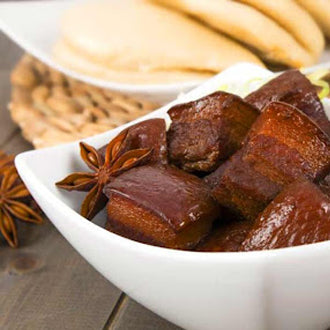
Mu Hong is a pork belly stew with a sweetened thick herbal sauce, a blend of Chinese and local cooking styles and ingredients. It is made of pork belly stewed with black pepper, garlic, coriander roots, five-spice powder, cinnamon, sweet soy sauce, oyster sauce and palm sugar. Its taste is sweet and salty, and the tender pork just melts in your mouth. It is usually served with steamed jasmine rice.
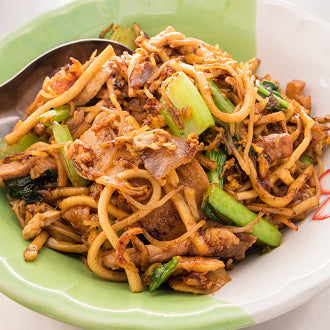
Mee Hokkien is Hokkien stir-fried noodles, named after the location of its origin in China. It is one of the most famous dishes in Phuket and easy to find almost everywhere on the island. The noodle dish is usually made of yellow flour noodles stir-fried with pork, seafood, fish balls, some vegetables and seasoned with soy sauce. It is sometimes served with an egg. Some restaurants serve the dish dry stir fried while others add an almost gravy-like broth. Mee Hokkien’s taste is savory and mild.
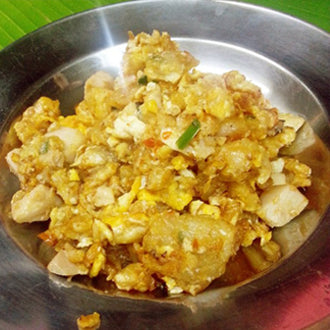
Oh Tao is a local dish that looks like an oyster omelet. Another dish which was taken from Chinese culinary. You can find Oh Tao on many street stalls in Phuket Town and across the island. It is made from a mix of flour and eggs, cubes of taro root, small oysters, pork crackling, spring onions and spicy sauce. Usually served with bean sprouts.
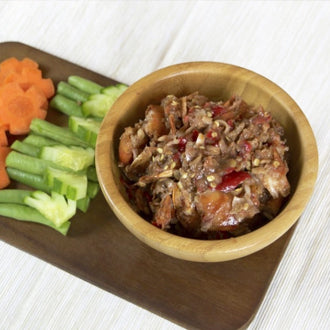
Nam Phrik Kung Siap is another famous Phuket dish which is a spicy chili dip. It is usually made with green Thai chili peppers, garlic, shrimp paste, fish sauce, lime juice, palm sugar and most notably, the eponymous smoked shrimp or prawns (Kung Siap). Its taste is quite unique - a balance of sweet, sour, and salty taste with a unique smell of grilled smoked shrimp. The dish is usually served with a platter of fresh or soft-boiled vegetables, and you can add lime juice according to your taste.

Khanom Jeen is rice noodles served with curry-like toppings, and it can be found easily across Thailand. But unlike other regions, Khanom Jeen is Phuket’s most popular breakfast (alongside dim sum). Typically, the noodles are served with spicy soup or curry, a huge selection of herbs, vegetables, fruit and seasonings that are meant to be mixed with the noodles and curry. The favorite local topping is Nam Ya Pu, a spicy coconut milk-based soup with crab, or Geang Tai Pla, a spicy and sour fish viscera curry.
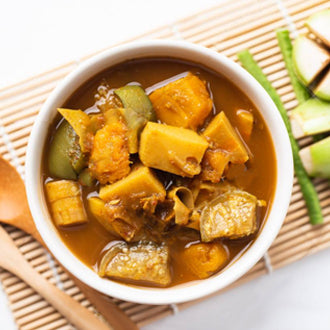
Gaeng Tai Pla is a spicy and sour fish viscera curry. It is one of the most popular dishes amongst the locals. This curry is made with an intensely flavored sauce of fermented fish innards and chilies, shrimp paste, lemongrass and a zesty blend of herbs and spices. It is a favorite for eating with Khanom Jeen noodle. In the past, Gaeng Tai Pla was served with fish only, but these days you can find a mix of vegetables like baby corn, carrot, winter melon and bamboo shoots added to the curry. This dish is usually made very spicy by local standards, so if you have a low spiciness tolerance, you might want to skip this one.
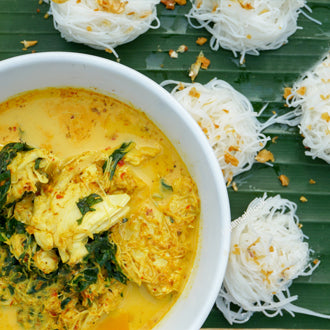
Gaeng Pu Bai Cha Plu is Phuket-style yellow curry with crab meat. The lump crabmeat is cooked in an aromatic curry infused with coconut milk, yellow curry paste and wild betel leaves. This Phuket specialty is often served with rice noodles and fresh vegetables.
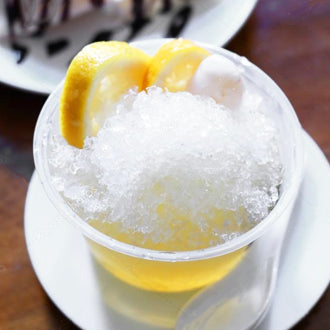
O-aeo is a shaved ice dessert known as a local specialty in Phuket. O-aeo is made from a mixture of banana, gelatin O-aeo seeds, which the dessert is known after. The dessert can be served in many ways including with red kidney beans or black grass jelly and shaved ice, or with red syrup on the top.
Each café or restaurant also has their own version / recipe for serving O-aeo. This local dessert is quite hard to find outside Phuket and even inside the town you can find it in a few cafes or restaurants in downtown area. So, grab a bowl if you have a chance to visit Phuket town.